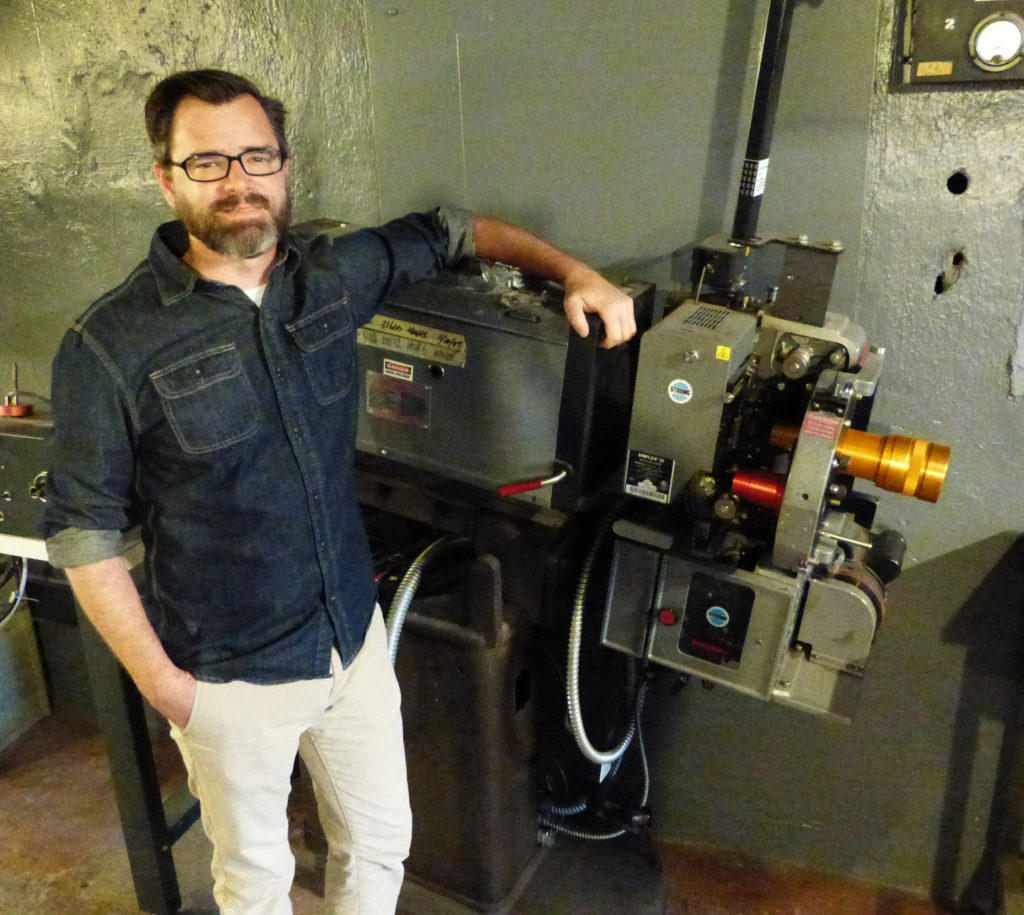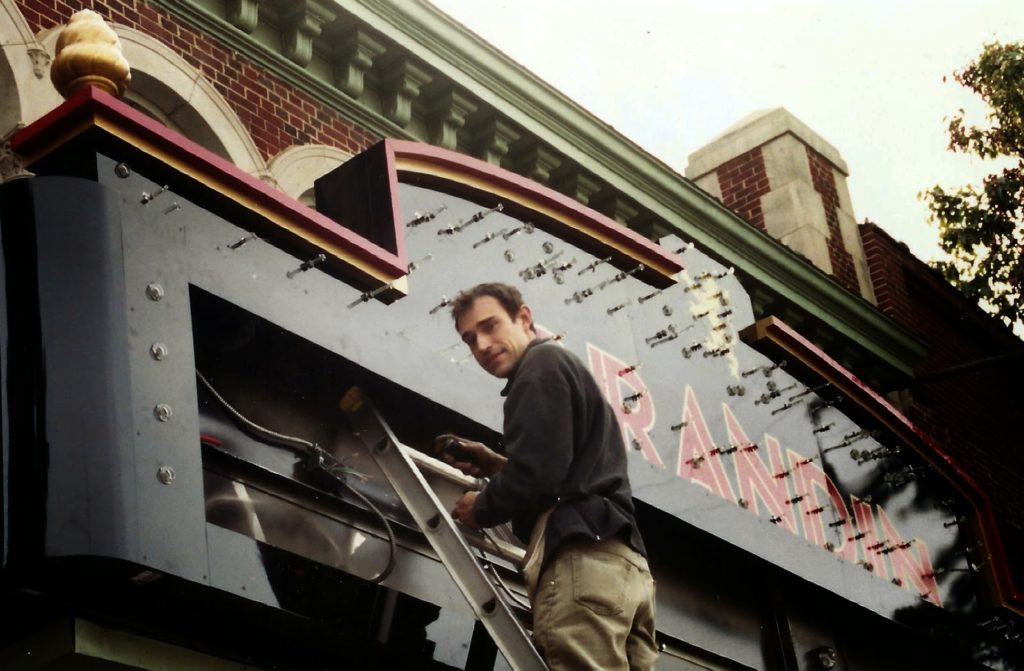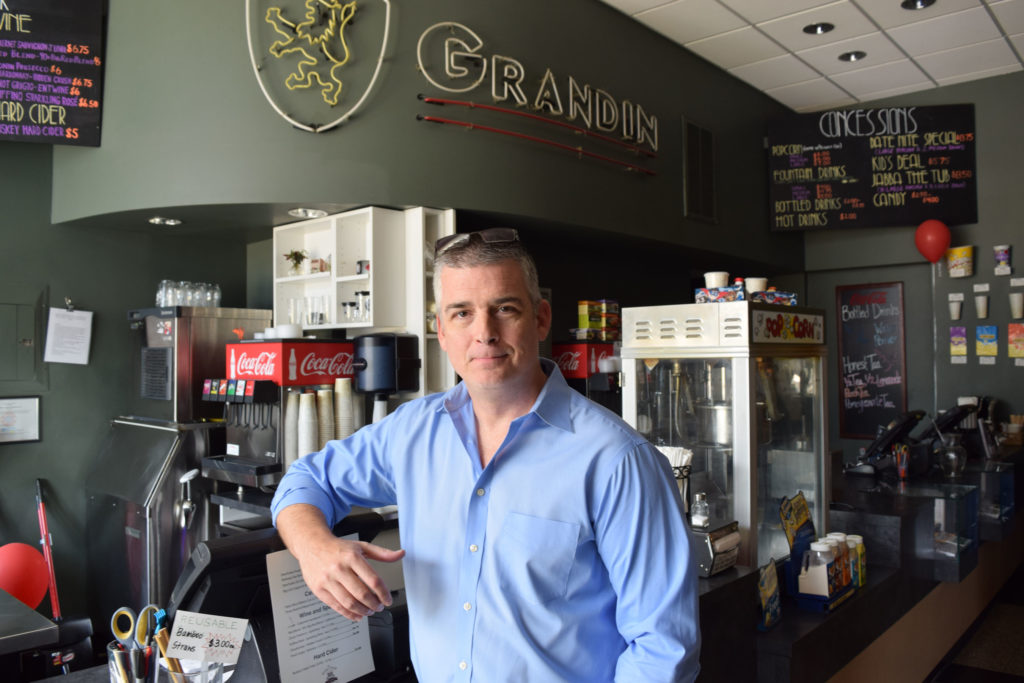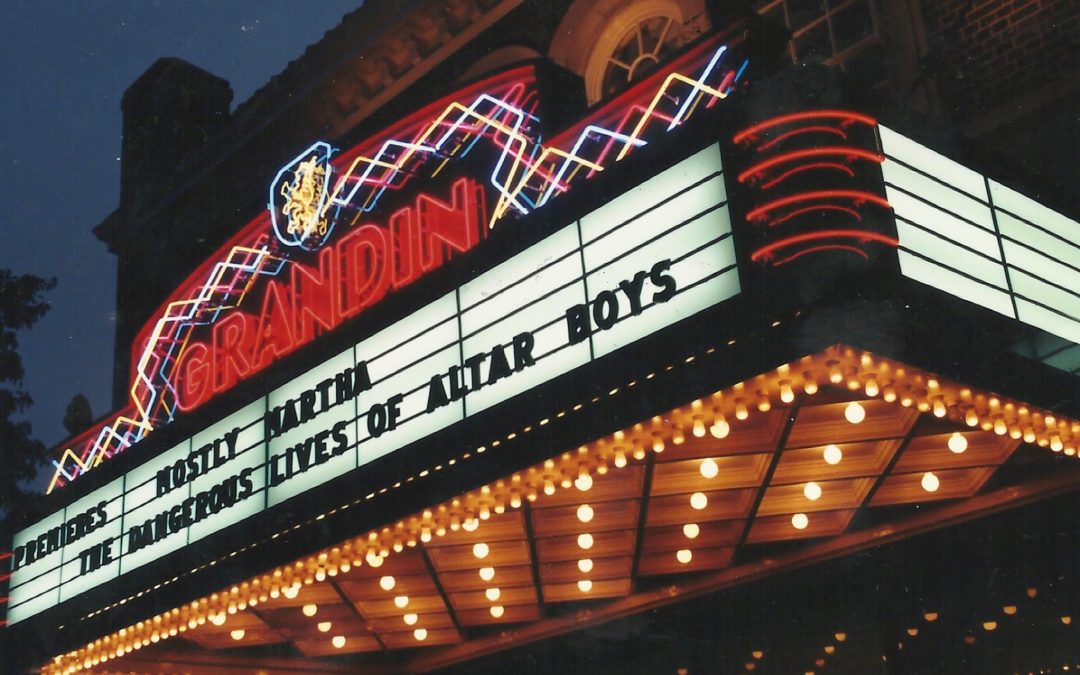Roanoke’s Grandin Theatre has undergone several revisions over the years and today stands as an example of what can be done when the arts community is serious about a project.
The Grandin Theatre, once one of more than 15 neighborhood movie palaces in Roanoke now occupies a niche that is unique in Western Virginia. Its four screens still feature popular movies on a daily basis, but they also screen foreign films, documentaries, independents, specialty movies and even those locally produced.
In recent years, it has been an occasional music hall, a live theater and a film lab where students turn out their own movies, some of them quite impressive. The Grandin is a community center, an art museum and a perfect setting for birthday parties. You can still find Saturday morning matinees for children there. It is at the center of a neighborhood economic development experiment that has become a role model for other neighborhoods and even other cities.
Over the years since it opened in 1932, showing “Arrowsmith,” the first movie with sound shown in Roanoke, the Grandin has changed hands several times and is now a non-profit owned and operated by the Grandin Theatre Foundation, formed in 2001 by Roanoke business notables Ed Walker and Warner Dalhouse.
Following is a look at how the Grandin Theatre developed and what it has become.
The Early Years
Roanoke’s history with movie theaters is more than a century old now, formally beginning with the opening of the Jefferson Theater in 1910. Many of the early free-standing, single-screen theaters—one a 5-cent small screen and three others Nickelodeians—closed by 1930 and most of the rest were shuttered by 1978 with the razing of the Jefferson Theater downtown.
Remaining today and standing alone is the Grandin Theatre, an entertainment center not as grand as the American was for many years, but one of the country’s last old-style, architectural mish-mash community movie house that has found a stable, healthy place in Roanoke’s culture.
Roanoke theaters in the first half of the 20th Century were plentiful, including the grand American, the Lyric, the Bijou, the Isis, the Princess, the Comet, the Virginia (for African-Americans), the Lee, the Electric Parlor, the Wonderland, the Azusu, the Boston, the Roanoke, the Jefferson, the Rialto, the Park and the Virginian.
When the Grandin opened on March 26, 1932 tickets cost a quarter for adults and a dime for kids. Fresh, aromatic popcorn, candy and soft drinks refreshed the audiences. The theater held 944 people on the floor and balcony and had “special equipment for the hard of hearing”.
Eubank & Caldwell architect John Zink’s creation mixed Spanish colonial, colonial revival, Italian Renaissance and classical revival—an odd combination if one exists. But it works, especially the gargoyles overlooking the main theater.
The Grandin remained an ordinary neighborhood cinema for more than 40 years, until it closed in 1976. It was, as it still is, the center of Grandin Village and a destination, though there was plenty of competition for the movie dollar (or dime, as it were). For a number of those years, the neighborhood and the theater were linked to downtown Roanoke by trolley, basically shrinking the size of Roanoke.
The Playhouse Years
The Grandin closed in 1976 because of financial challenges and was taken over by Mill Mountain Theatre which produced 30 shows like “The Sound of Music,” “Guys and Dolls” and “Annie Get Your Gun” over the next seven years. Mill Mountain’s home on the mountain had burned to the ground, leaving it with no place to go.
Jim Ayers and Mona Black helped lead the MMT back at the Grandin.
Jere Hodgin, former creative director at Mill Mountain Theatre after it moved to its permanent home in downtown Roanoke, says, “Fewer than a dozen people acted in all three Mill Mountain venues and I’m the only one left who directed at all three. I stood there and watched Mill Mountain Theatre burn on the mountain.”
Today, Ginger Poole the MMT creative director, says simply, “Without the Grandin Theatre, we wouldn’t be here.”
The first season for the live theater was called the “Phoenix Season” and actor/director Ernie Zulia (now head of the Hollins University Theatre Department) says, “We had theater ghosts and movie ghosts at the Grandin.”
The legend of those movie ghosts remain strong.
The Music Hall
In 1983, Jack Andrews bought the Theatre and screened classics, second run movies, and art films. He also presented live music shows. During this time, blues musicians such as John Lee Hooker, Ray Charles and BB King rocked the house.
In 1984-’85 Phillip Poff began bringing in music shows, most of it reflecting his taste for blues and jazz: Bobby “Blue” Bland, Ray Charles, B.B. King, Buddy Rich, John Prine, Delbert McClinton (who kicked off the series with the local Rhythm Doctors opening for him). Chet Atkins and Tammy Wynette added a country flavor. Poff did it on a wing and a prayer: “We didn’t have much money,” he says.
Beginning in 1984, there were 13 shows in 13 months. He had to schedule two Ray Charles shows in a day to pay the legendary musician. In the end, “we lost a lot of money but …” His voice trailed off.
The Lindsey Years
In 1985 the Grandin closed its doors once again, this time due to financial issues. However, in 1986, the theatre opened under the ownership of entrepreneur Jim Lindsey and the guidance of manager Julie Hunsaker, his sister.
They brought in art house, indie and foreign films, re-decorated the theater with 1930s flair and added programming to get the community involved. Hunsaker even brought in comedy legend Bill Murray, who in 1990, hosted a benefit to help the Grandin pay its bills.
Lindsey says buying the Grandin was not a spontaneous decision: “I had been obsessed with having a movie theater for years,” he says. “I went all over the region looking for one and even considered the Jefferson when it closed. I looked at a lot of buildings with converting them in mind.”
When the Grandin Theater came up for sale, he jumped at the opportunity, looking at the Vinegar Hill theater in Charlottesville for inspiration. “It is what the Grandin became,” he says, “but we did things they didn’t do.”
The theater had one screen at the beginning and that was found to be financially limiting. “We were showing two or three different movies a day, and having mini-festivals. But we finally realized we couldn’t do it with one screen.” So two screens upstairs and a screening room downstairs were added. Another screening room downstairs behind the concession stand came a bit later. All of that increased capacity and potential for variety.
“We had been losing money rapidly,” says Lindsey, but the bleeding stopped with the additions. “We started climbing back and in less than a year after we opened” the theater was doing well.
Lindsey credits his sister with making a huge difference in perception and in fact. She was the creative genius and the face of the theater in the community. “Julie created so much enthusiasm,” Lindsey says.
Then unanticipated problems arose with distribution, which would eventually lead to the theater closing again. “We were getting sub-runs, foreign films and films that didn’t come here,” Lindsey says. “We had to juggle the mix. Distributors, however, “got stronger and meaner, trying to block us at every turn. The big theaters were dominant in the area” and didn’t want the Grandin to succeed.
Grandin was operating with 93 percent of its revenues coming from tickets and concession sales. The generally accepted blend is 60 percent tickets/concessions and 40 percent from other sources. In November of 2001, The Grandin Theatre was forced to close for the third time because the numbers just didn’t add up.
The Grandin had become a community treasure again under Lindsey and Hunsaker, even to the point of helping raise a lot of Raleigh Court’s children at its ticket booth, concession stand and film room. Several of them went on to careers in the movie business.
Up To Date
The effort to save the Grandin one final time fell to the people of the Roanoke Valley. Under the guidance of developer Ed Walker, whose specialty is renovation of old property, and retired banker Warner Dalhouse the Grandin Theatre Foundation was formed. Over the next year, the Foundation raised $1.5 million to buy and renovate the theatre, with architect Richard Rife providing the drawings.
At one point, Roanoke City Council held a vote to approve a $50,000 matching grant for the theater. Walker called a Foundation board meeting to announce Council’s decision and led with this: “City Council has just unanimously approved our funding on a 6-1 vote.”
Now, the work had to begin.
Jason Garnett, who had been with the theater in one capacity or another since his teenage years in the 1990s became projectionist and later general manager. He recalls the renovation in 2002:
“When I started, there were five screens. Where the concession stand is now was another screening room that sat maybe 35 people. The booths were a mishmash of equipment. Every booth was different with its own idiosyncrasies with various models of Simplex and Century projectors, all made between the 1930s and ’50s but they were workhorses and were part of the charm. The sound systems were a mixed bag too. Every room had something different.
“When we renovated the theatre in 2002, all the booths were made uniform with the exception of the main, where we splurged for Dolby Digital.” More improvements followed.

Garnett says, “The theatre reopening was an exciting time. There was a bit of nostalgia for Julie’s time there, though. She brought a charm to the place that was missing after the renovations. I remember opening night being extremely stressful. We had been working 15-plus hour days trying to get the booths up and running.
There was a gala next door to the theater opening night and the theater was to open with an evening show, but the late Mark Jamison, known as the Neon Man had not completed the marquee. He was on a ladder working furiously until virtually the last minute. Says Garnett, “We couldn’t find a color photo of the original marquee so he estimated the colors by the grey scale of the black and white photo we had.” That worked and people who recalled the original marquee said the reproduction was spot-on.

Success was sporadic for the next few years under the guidance of Executive Director Kathy Chittum. She was quite good at getting movies and running the theater. But she made it clear she was not a fund-raiser, something the board expected from her. Eventually, the board dismissed Chittum, replacing her with the estimable Ian Fortier, who was at the Jefferson Center at the time in August of 2014.
Fortier almost immediately stabilized the theater and established its Film Lab, a school for youngsters to learn film-making, something Garnett had suggested to the board for years.
Buying the theater from the Lindseys, says Stavola, “was a leap of faith. When we agreed to buy, we didn’t have the money.” That meant creating ways to bring it in and the ideas came fast and furious with much of the community taking part. There were sidewalk stars ($1,000 each, which could be paid for with a credit card), plaques on seats, children-led fundraisers, and others.
Rife says, “We expanded programs with special events and showings, building a relationship with interested groups.” Autistic children were brought in for a film with lights up and sound down; there were programs for the city’s Jewish community, for African-Americans and “we brought in people to expand the base.”
With Fortier running the show, the theater stabilized financially in a hurry. The pay scale has improved and the Grandin has gone to green power use and green habits (composting drink containers, for example).

Fortier had earned a reputation as an innovator while second in command at Roanoke’s Jefferson Center and he almost immediately proved how sound the reputation was. There was considerable operational chaos at the Grandin when he stepped in. Fortier recalls, “Ads were not screened, movies not beginning on time, staff morale down, no leadership, a non-friendly environment, cleanliness, inconsistencies throughout.”
Fortier says, “A lot of people came to the theater, but they were not made to feel good about it.” That was about to change. He was looking for what he calls “standard business protocol.” In 2015, he sought to rebrand the theater. It was an historic landmark, an icon and that was useful. “It was so much more than a theater” and the challenge was how to present that reality.
The Grandin is now in its seventh straight year in the black and has no debt mostly because it has expanded its base and found new ways to bring in money. “I’m surprised how quickly it happened,” Fortner says. “We just stormed through it in 2014” and the success has continued unabated. “It was 90 percent ticket sales and concessions when I got here, but now it’s 65-35” and the theater was just granted permission by the state to sell alcohol.
“The Grandin will continue to evolve,” says Stavola. “It is a product of this community believing in itself and investing in itself.”
(Dan Smith is a veteran journalist with more than 50 years’ experience, much of it in Roanoke. He is a member of the Virginia Communications Hall of Fame and a former Virginia Business Journalist of the Year. He has won many awards in all phases of news production, including design and photography, news, sports, feature writing and editorial. His Public Radio essays have won state awards and he is the founder of the Roanoke Regional Writers Conference at Hollins University.)

